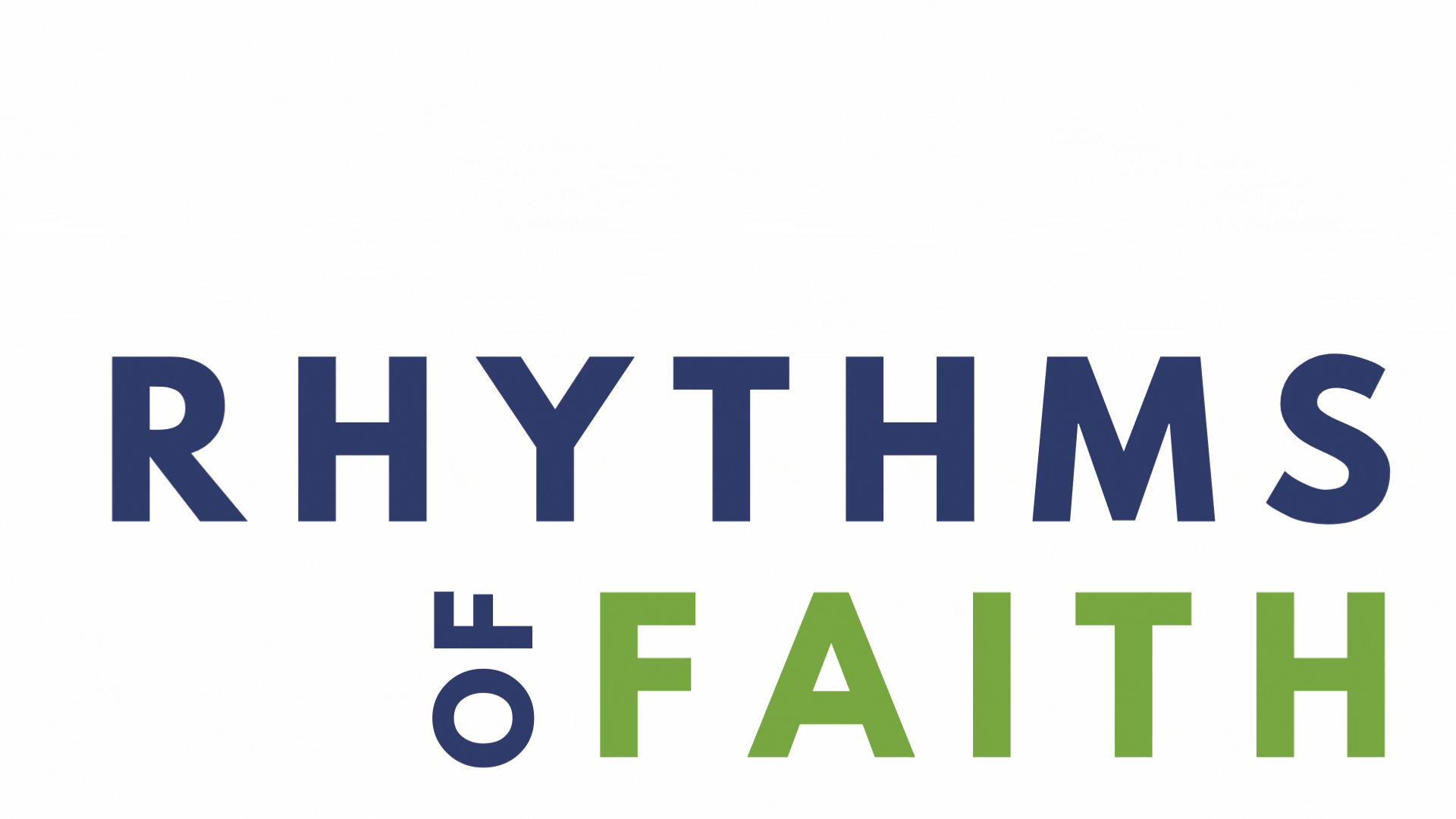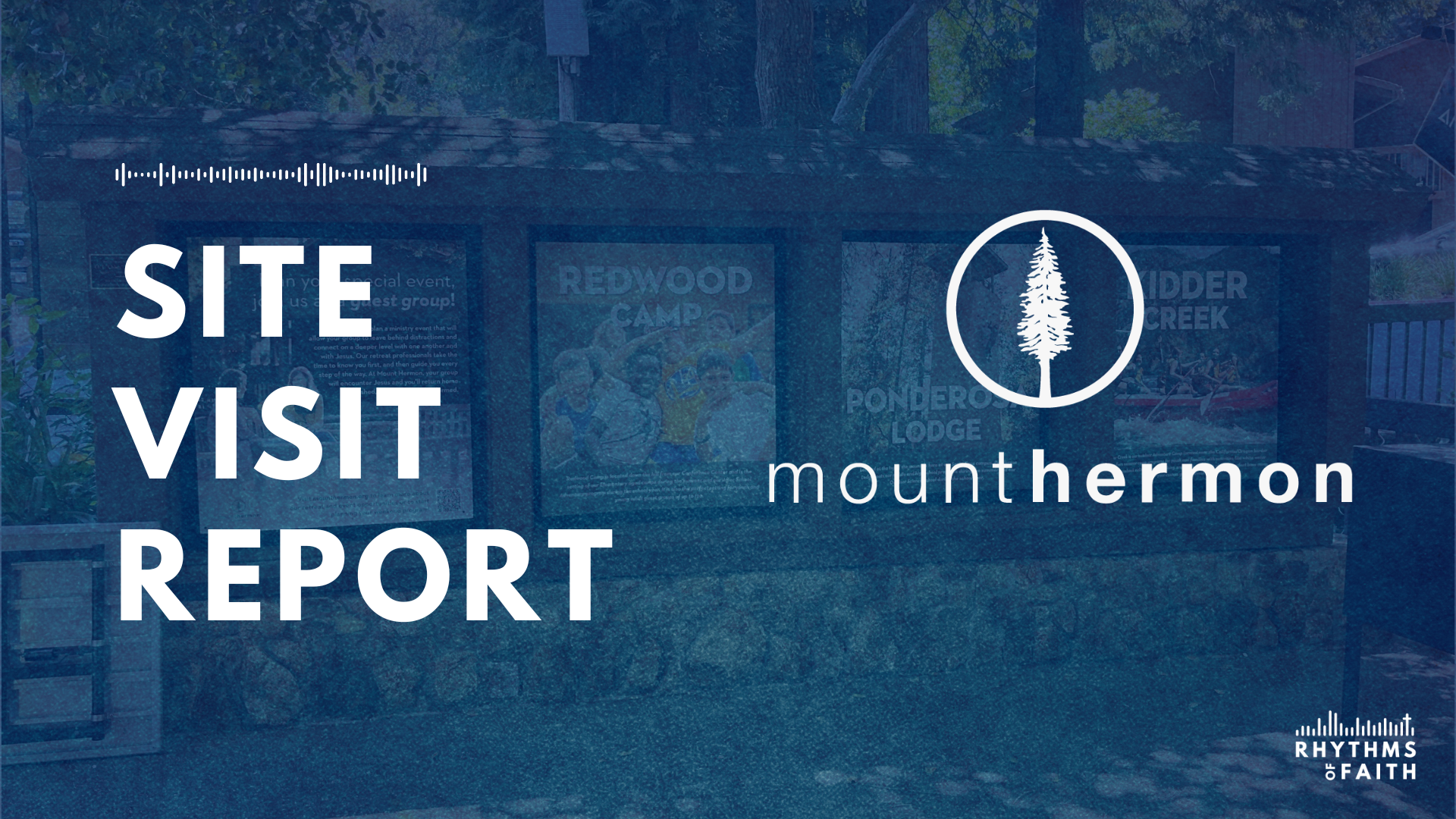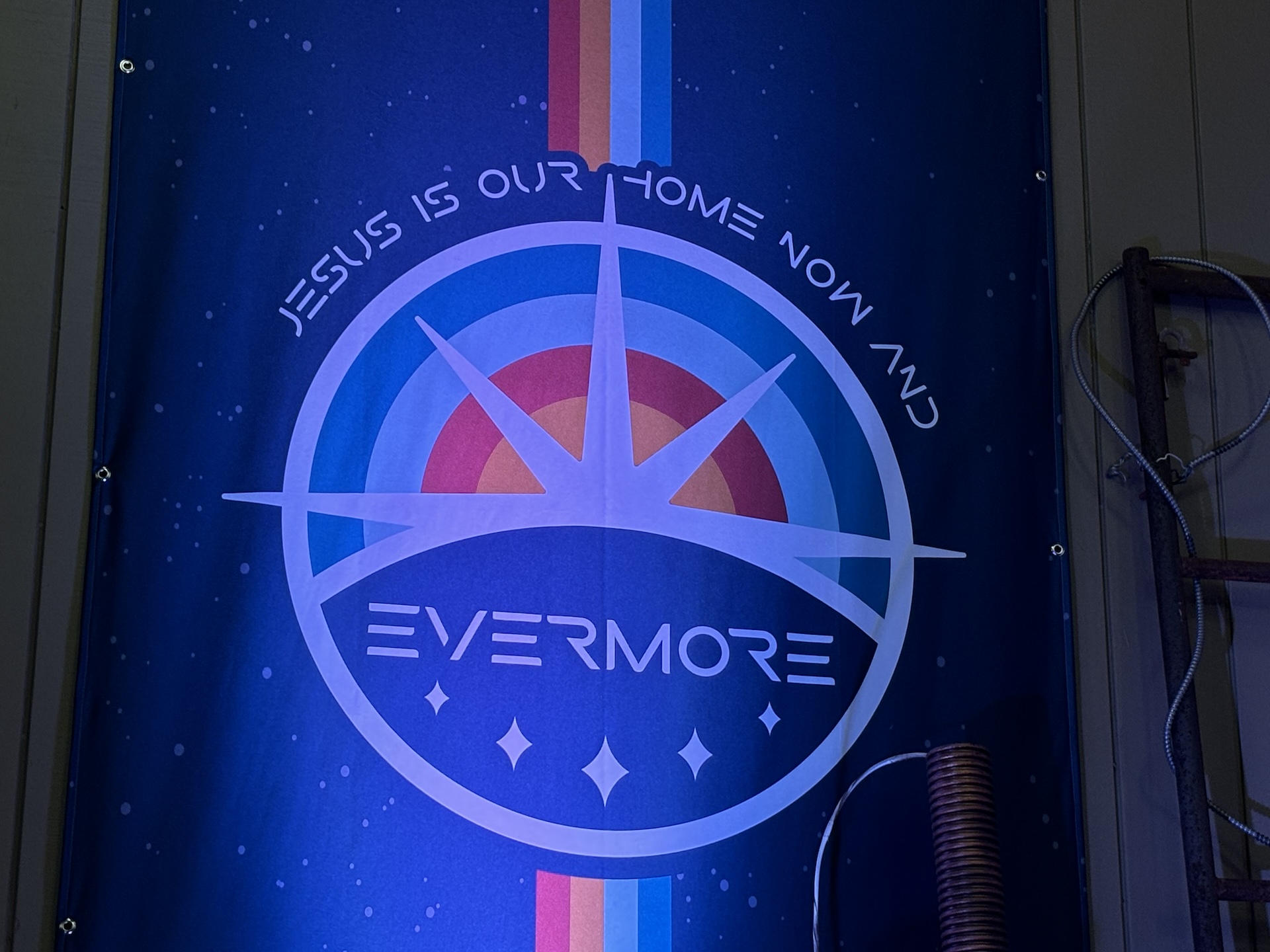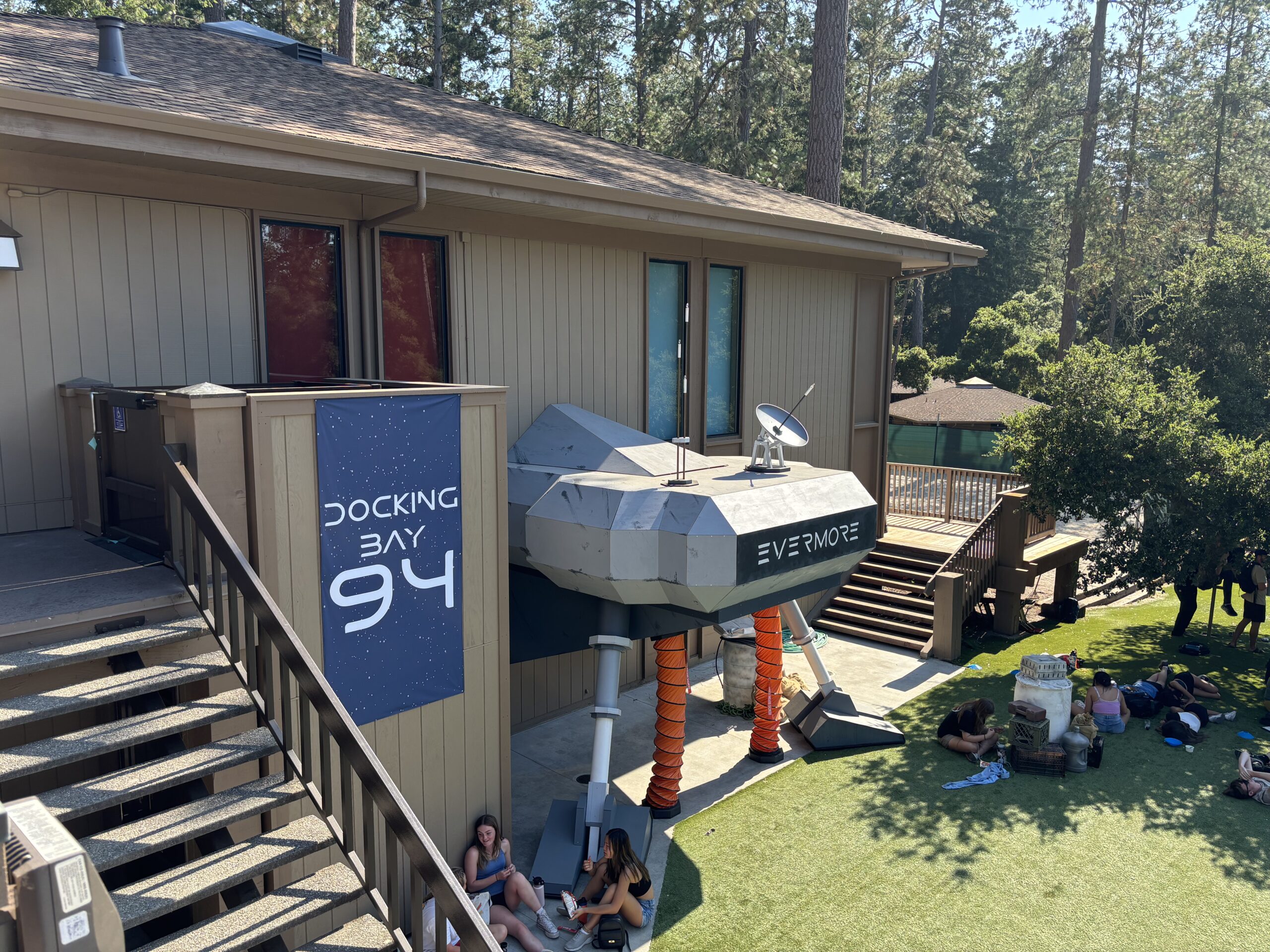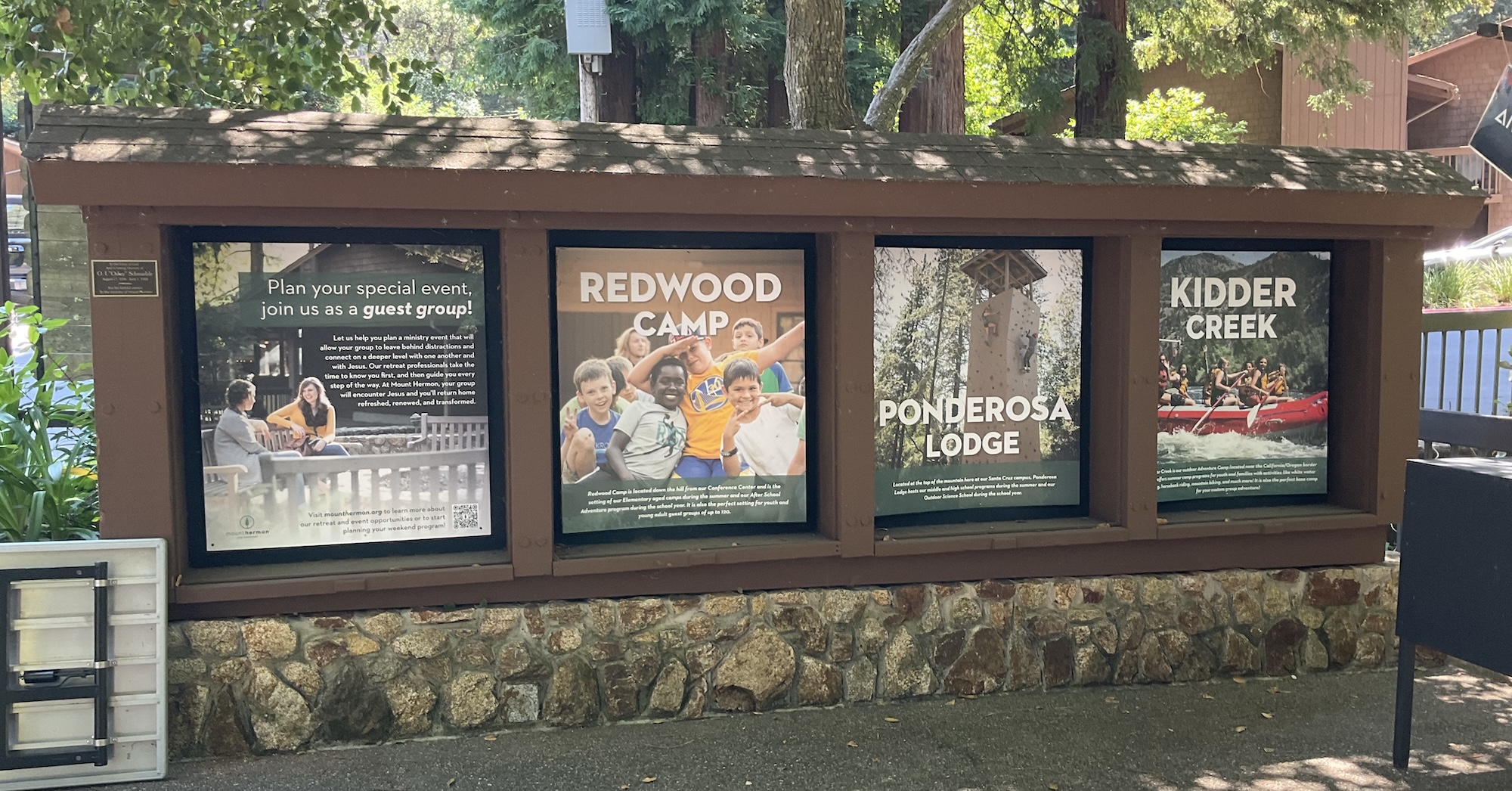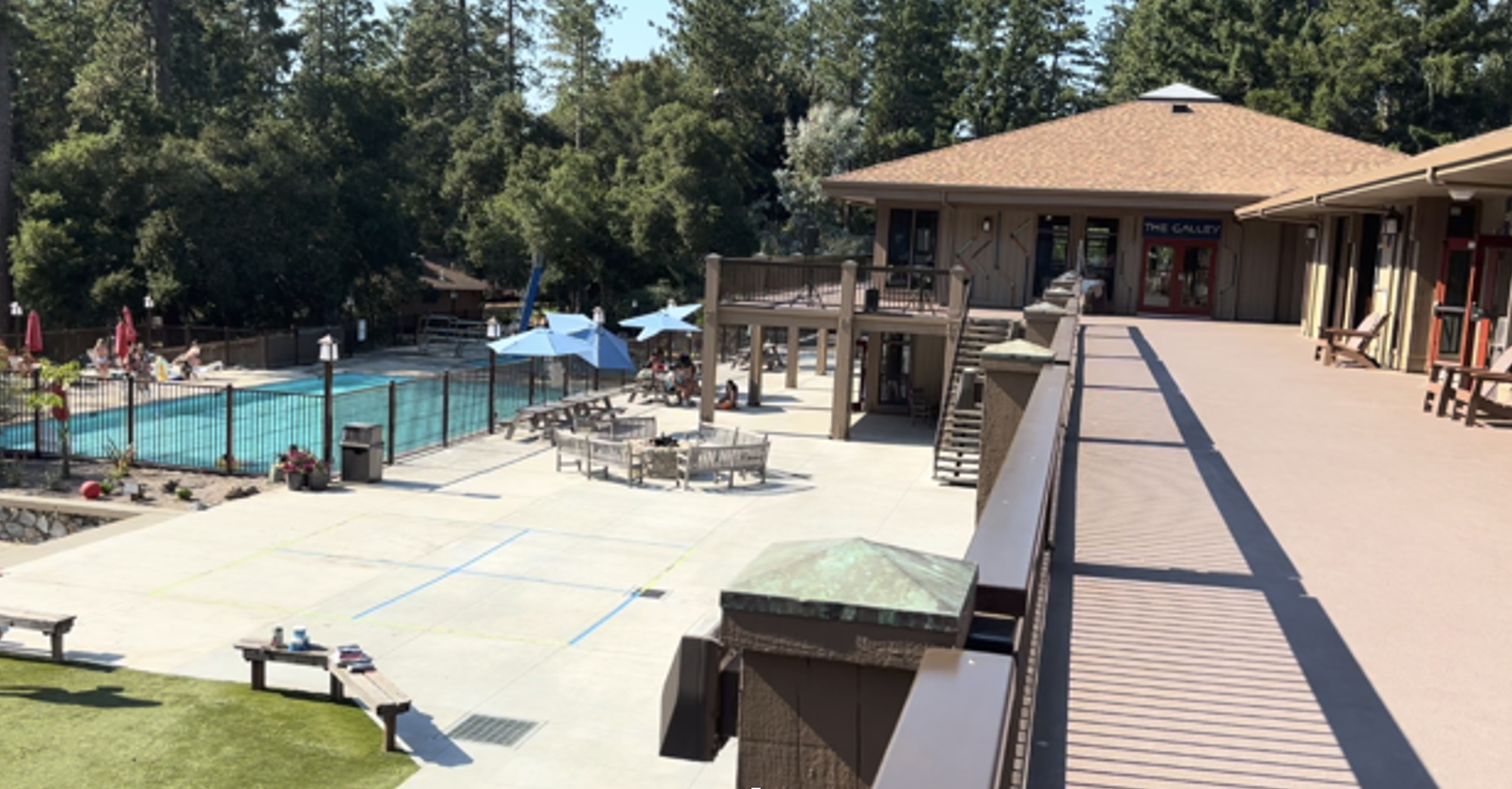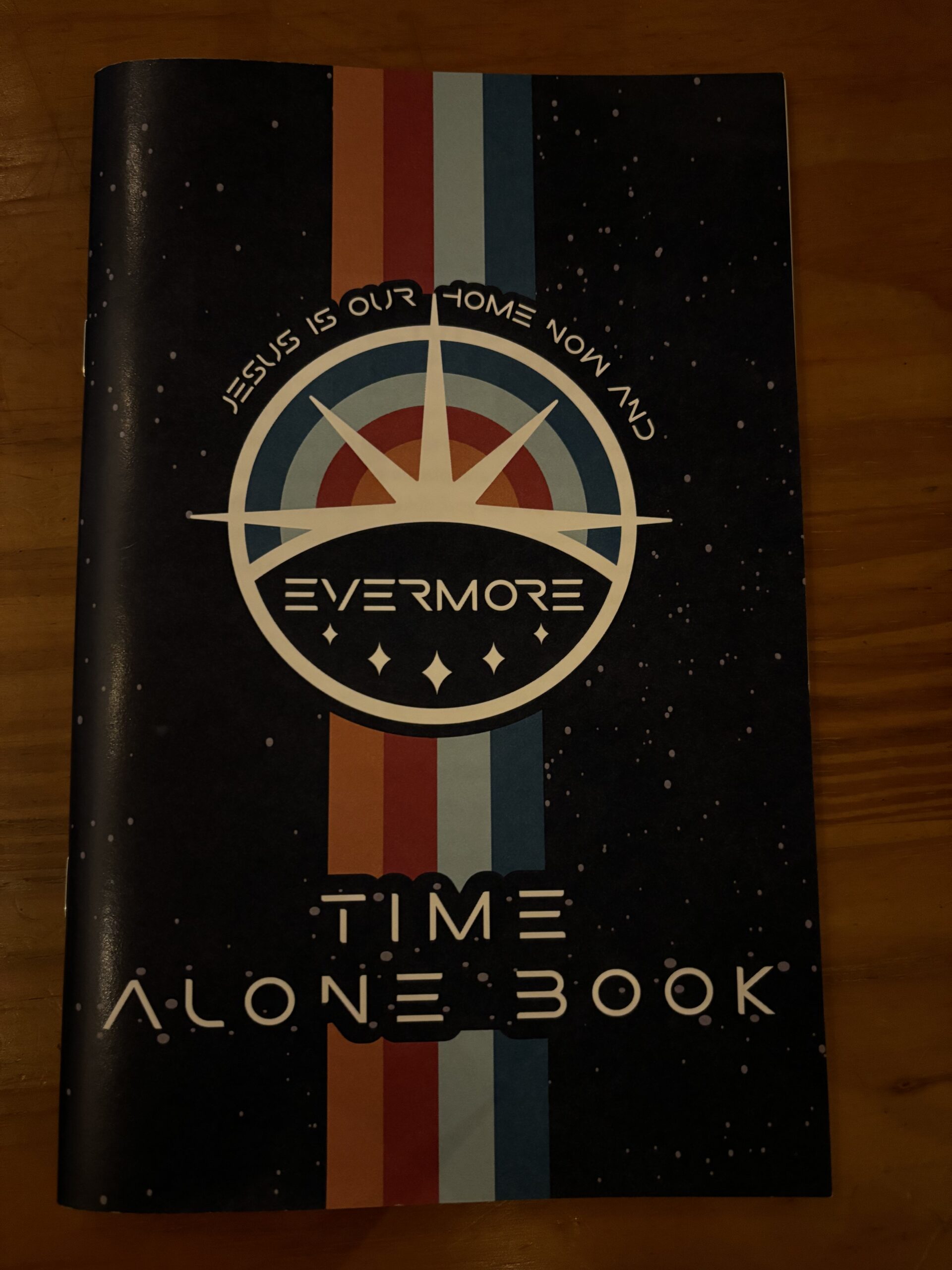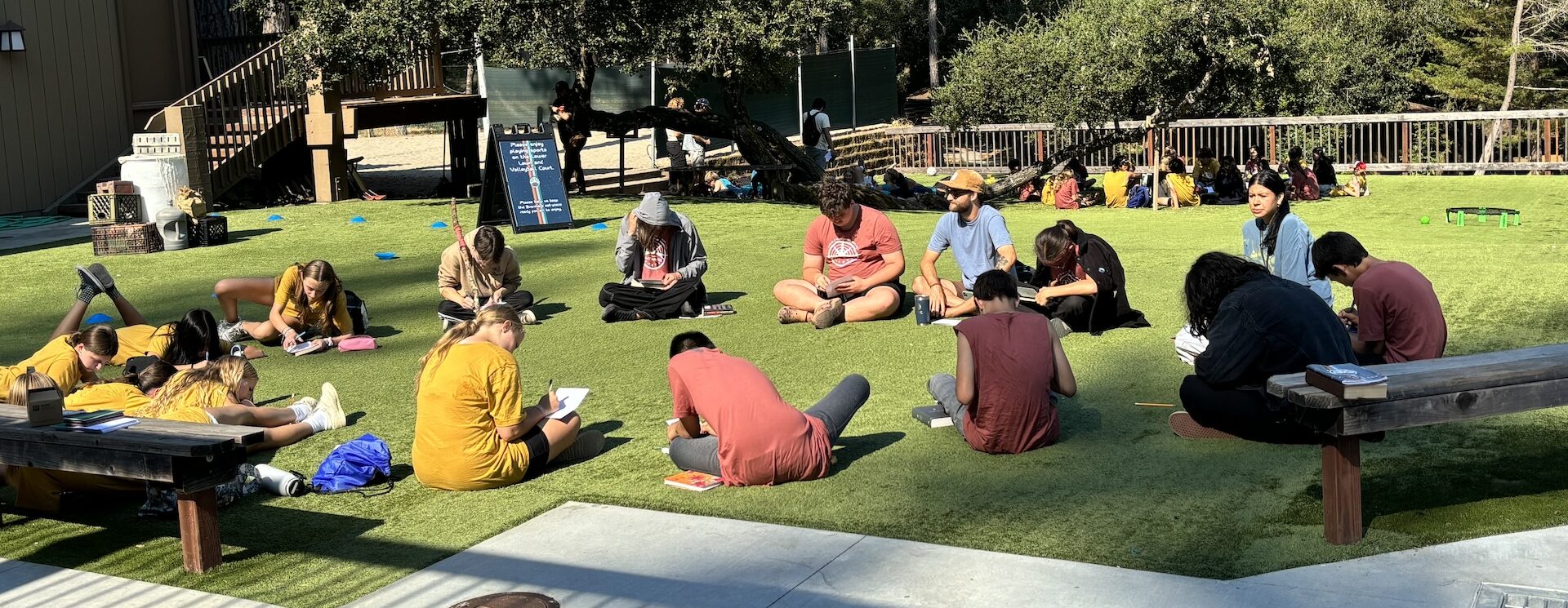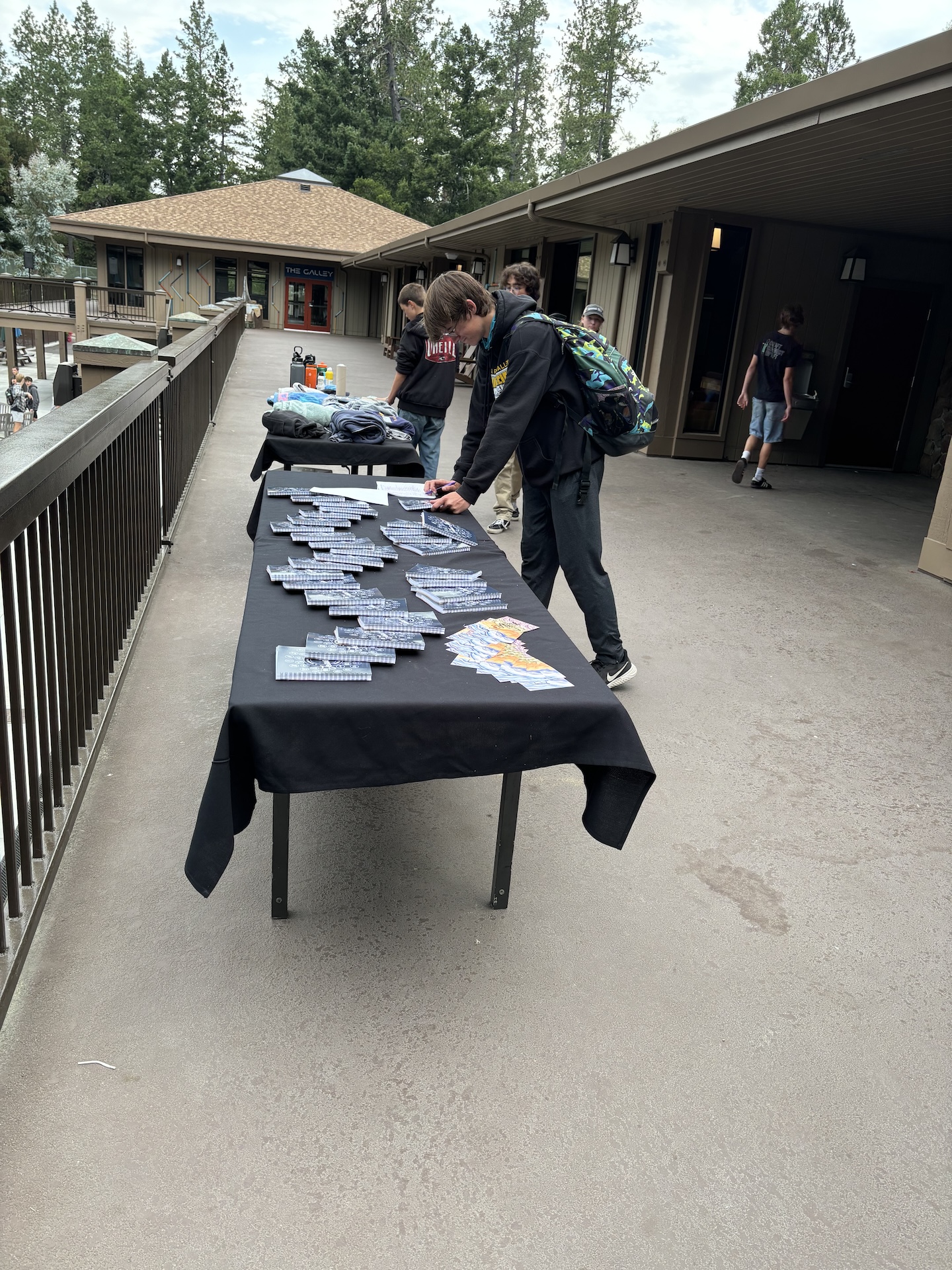“Jesus is our Home, now and evermore.”
This was the theme for summer youth camps at Mount Hermon Ponderosa Lodge, Felton, California in the slopy redwood forests of the Santa Cruz mountains. Per the Ponderosa website, six weeklong youth camps took place this summer from mid-June to early August, three for junior high and three for high school campers. I observed the last four days of a high school week from Wednesday 10th to Saturday13th as a researcher for the Rhythms of Faith Project, which explores the influence of camp strategies and church partnerships on family faith practices.
The theme, simply abbreviated “Evermore,” was prominent all over camp, replete with a logo and the tail end of a space ship model (in the likeness of Han Solo’s Millennium Falcon from the “Star Wars” franchise) by the same name sticking out of “Docking Bay 94,” on the outer wall of the Forum, the camp’s main auditorium. My visit was the season’s second High School camp. This centralized program had about 120 campers drawn from two subgroups, one recruited by two churches and the other from open registrations.
Meet Mt. Hermon
Mount Hermon has four centrally administrated but distinct campuses, each with a different program focus and leadership. At their original site in the Santa Cruz Mountains is Mount Hermon Conference Center, which hosts intergenerational family camps, large conferences, and retreats. Half a mile east of that is their Redwood facility for grade school campers, and close to a mile southeast, Ponderosa Lodge. A fourth remote site, Kidder Creek adventure camp, is seven hours north of Santa Cruz. Mount Hermon, I learned at a family camp seminar that I crashed during my visit, was founded in 1906. Its history boasts many world-acclaimed Christian leaders at conferences and retreats. In the early 1950s, the story goes, Billy Graham was with a group on a wooded ridge near the main conference center, when he cast a vision for the site to become a facility for youth camps. Ponderosa Lodge was to run its first camp there in 1969, directed by Ron Demolar, who still lives next to the site.
The Lodge has three facility clusters terraced on a wooded slope: an adventure activities course; a split-level main building complex with a dining hall, game rooms, auditorium, snack shop, and meeting rooms by a swimming pool; and four six-cabin villages.
I arrived at the Lodge late on Tuesday night. The following morning, Kelsey Patterson, the Pondarosa Youth Camp Director oriented me to the program and facility over breakfast at “The Galley,” the Star Wars-themed dining hall replete with a blue doorway sign. Each day, campers gather for mealtimes on the lower deck next to the swimming pool for announcements and prayers by a counselor perched on the upper deck. Campers then pick their buffet-style meals and sit wherever they want, including outside or in adjacent meeting or game rooms. All meals and hangout times are accompanied by music audible throughout camp, creating a festive, party feel. This setup helps campers hang out and nurture friendships.
The camp schedule is similar on most days. After breakfast comes a half hour of competitive games featuring four large, preassigned, coed Star Wars themed teams, to get campers going and ready for the day ahead. This year’s teams are Cosmechanics, Stellarcoms, Solatrons and Astroneers, each with a team color. The next half hour, campers break into “Family Groups” matching boy and girl cabins for experiential activities that introduce the day’s theme.
Theme Integration Throughout Camp
This week’s theme was drawn from John 13-17, a chapter each day. Monday’s focus from John 13 was “Jesus loves us-he is Lord” from the foot washing narrative. On Tuesday, John 14: “Jesus prepares a home for us – he is the way home.” Wednesday: “Jesus Abides in us – he is Teacher” from Jn 15. Thursday: “Jesus gives us Holy Spirit – he is our Friend” from Jn 16, and Friday: “Jesus wants to be with us – he is our Home” from Jn 17. After family groups, campers go off on their own to explore the theme deeper using “Time Alone” workbooks and their Bibles.
The workbooks include a “check-in activity” that taps into daily life experiences, a section exploring the day’s scripture, a “prayer map” that personalizes the lesson, and a “main take-away.” The workbook is one of several literature resources annually designed and produced by Kelsey. She also writes a staff training manual that lays out the philosophy of Mt Hermon, a developmental “Working with youth” section, camp policies and practices, and a journal for the training week. Staff also receive a pocketbook that has daily resources to support leading activities and themes. Campers may take home “The Challenge,” a month-long daily devotion also written by her. This year, it is themed “Jesus is King” and explores the life and work of Jesus. Kelsey is a graphic designer whose gifts are evident in these resources. She also helps design props such as the “Evermore” spaceship and the Forum stage set as “The Bridge” command post.
After Time Alone, campers go to Morning Forum at 10:30 for sung worship led by a praise band, whose members double as support counselors. This is followed by a skit that through the week depicts home-life types for four teen characters. Monday’s teen comes from a noisy, chaotic home with no personal space amidst squabbling siblings and distracted parents. Tuesday, the opposite; teen comes home to an empty house because parents must work multiple jobs. Wednesday’s parents fight all the time, and the teen sneaks out just to get some peace. Thursday’s is the perfect home – a model, engaged family, a safe place for teens. All come together in Friday’s skit, with the healthy teens inviting the hurting to their youth group and home. The message encourages campers to support one another beyond camp. Next comes a half hour of cabin group discussions to reflect on the theme of the day.
Afternoons are for group bonding activities with minimal teaching time – team rallies, pool games, cabin activities, cleaning up, a beach day, and lots of free time. Evening Forum in “The Bridge” happens after dinner. This 75-minute program has sung worship followed by a skit with Wizard of Oz/Star Wars mish-mash characters such as Raven/Han Solo, Leo/Chewbacca, Tin Man/C3PO and a cowardly lion/Dot. Through the week, the Evermore is attacked, captured, rescued, and on Friday, ushered home by GLIN/Apostle Peter, whom they thought was dead. The set has a live screen of passing celestial bodies, occasionally interrupted by Apostle Peter/Holy Spirit offering guidance.
These daily skits set up the main speakers, who bring the day’s lessons home. This week’s speakers were the Galbraiths; Jordan and his wife Lacey who developed a painting adding on each day’s teaching. Jordan and Lacey participated in some camp activities and attended staff meetings to touch base with campers. They prepared staff for reflection time that would follow the teaching and painting each night. From John 15 on Wednesday night, they shared a personal story on how the Father was pruning them through an ongoing personal struggle. They taught how God has a Process and Purpose for the Pruning (3 P’s) seasons of life (John 15:1-4). This session struck a chord, leading to tearful small group reflection and discussions for campers. Bedtime each night was 10:15pm.
What Campers Had to Say
My first camper focus group was scheduled for Thursday afternoon at the start of free time. Participants were campers from two churches from neighboring counties. Two counselors were present, as required by California law whenever adults meet any group of campers. Eleven campers showed up, which was a pleasant surprise. At first, they spoke nervously fast in response to my questions, but soon relaxed and conversation flowed. They couldn’t say enough about how much camp was impacting them, their faith, their relationships, and how much fun they were having. The previous night’s highly emotional pruning theme showed up in the conversation. They named camp as a healthy, relational, and spiritual “mountaintop experience” and talked of the need to transfer what they were learning back to their homes. Several said they would take home “The challenge” devotional for continued growth. They said there was continuity with their churches, whose staff were at camp. Though the majority came from Christian homes, it was not clear to them how family faith practices might be influenced by camp.
A second camper focus group was scheduled for later that afternoon, but only one camper showed up. We postponed it to the following day at 2:30, when two male campers showed up and I chose to proceed. The perspectives of these participants were understandably limited, but they too talked about how camp highly impacts their lives, especially in building relationships. I reflected on the participation disparities between the two groups and thought of two possibilities. The timing for the second group was problematic on both days. On Thursday, it was so deep into free time that campers were too invested in connecting with each other to be interrupted. Friday was their last day together, and they were understandably unwilling to give up any of their last scheduled free time. A camper later told me that he didn’t show up because he had a spike ball challenge to win. Another possibility for the disparity between the two groups may be because church groups are just easier to recruit by church leaders, who know and are trusted by their campers.
What Camp Staff & Church Leaders Had to Say
Six church leaders all with staff roles at the camp participated in the focus group on Thursday during dinner. They lauded the camp’s programming and teaching content, mentioning growth they saw in their teens. Their presence at camp provides easy follow-up back at church. They reported that the focus group discussion inspired new follow-up strategies for them. However, they were hard pressed to articulate how camp influences family faith practices. Churches, they said, can pair students to hold each other accountable to completing “The Challenge” devotional. They wondered (adding to an earlier conversation with Kelsey) what it would look like to offer parents good questions as conversation starters with their kids on the drive home from camp, agreeing that “How was camp?” is paralyzing. Perhaps a parents’ version of “The Challenge” or something similar to the camp staff pocket guide might help parents.
The camp staff focus group on Friday night during dinner was also quite delightful and went on for over an hour. Mount Hermon, they said, has a singularly strong connection with churches in the Bay area and beyond. Some counselors grew up attending Mt Hermon, right from Redwoods, family camps, and “Pondy.” One had attended a “Super-seniors” camp after graduating high school. Some had even taken The Challenge home as campers, though one reported he only made it to the 8th day. Another completed the entire 28 days because of partnering with one of his friends. The counselors affirmed my thoughts that the most powerful gain from Ponderosa may be peer connections forged. The challenge was how to keep these cohorts going after camp and how parents might leverage that to add to family faith practices.
On Saturday, the final pick-up day, parents joined campers and staff for an outdoor breakfast at Pancake Ridge just north of camp. None showed up for my scheduled focus group, but I was able to attend the 45-minute closing later that morning. Parents joined campers for sung worship, watched a high-energy camp show-and-tell video, and a vote of thanks to team members. Soon after 11am, families began to depart. On the upper deck was a table with The Challenge devotional, postcard replicas of the completed painting by Lacey Galbraith, and Lost and Found items. Parents perused these items as they passed by. I learned that after families left, staff would have a final meeting, after which everyone takes time off until the next camp starts the next day at noon.
Reflections
“If my parents gave me the choice of a week at Disneyland or at ‘Pondy,’ I would choose Pondy,”
This was what one camper told me. Ponderosa is much loved by campers and staff alike. It is the yearly highlight where they come to encounter God alongside their best friends, while enjoying fun, fellowship, healing, and growth. The Word is central, and the theme of camp is carefully woven into the progression with all the activities and props, allowing for whole person immersion in God’s truth. Kelsey, the director, is an amazingly gentle yet firm presence, personable and able to keep clear boundaries. She is on top of logistics, staying present while allowing key staff to run events without her occasionally. She clearly cares for her staff. There is an impressive leadership pipeline from camper to staff, with her influence clearly visible.
Ponderosa’s five stated values (intentional, excellent, Jesus-centered, relational, and camper-focused) are lived out with fidelity. I was especially intrigued by the spaces created to nurture deep peer relationships – the free times, camper chill times, the beach day, and social events every night. Those strong peer connections may be the most tangible benefits of Ponderosa. I wonder how they can be encouraged beyond camp and somehow leveraged to contribute to families’ faith practices. The challenge, of course, is that campers don’t live in the same geographical areas– except for those from church groups. The most visible takeaway tool for campers was The Challenge devotional. Kelsey shared that there once existed more resources for parents to take home, which have not been reinstated since the COVID disruptions. Mount Hermon does, however, have a strong intergenerational ministry through family camps and conferences. These prior camps no doubt contribute to the power of youth camps at Ponderosa.
